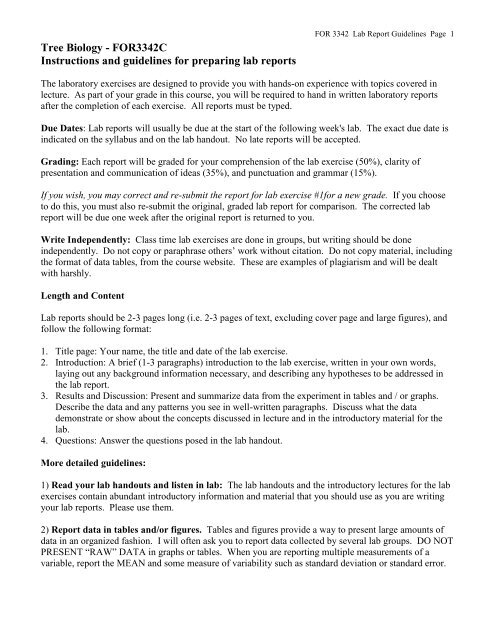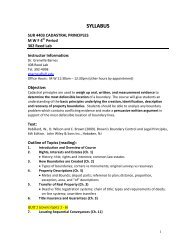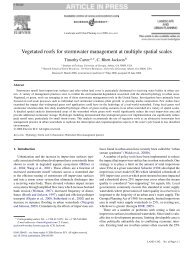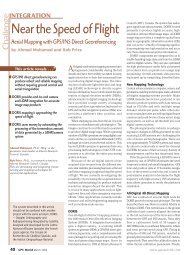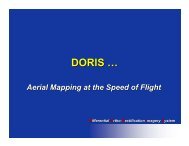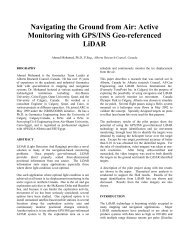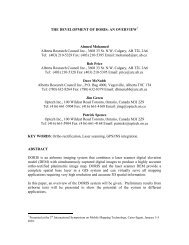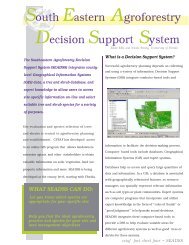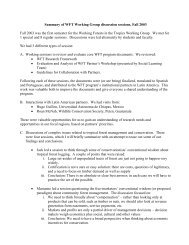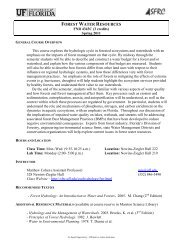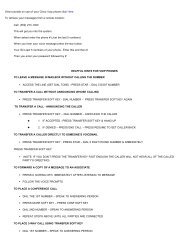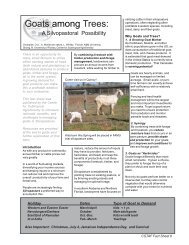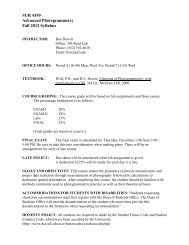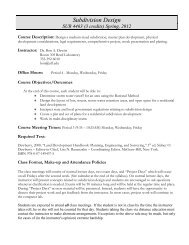Guidelines for preparing lab reports
Guidelines for preparing lab reports
Guidelines for preparing lab reports
Create successful ePaper yourself
Turn your PDF publications into a flip-book with our unique Google optimized e-Paper software.
Tree Biology - FOR3342C<br />
Instructions and guidelines <strong>for</strong> <strong>preparing</strong> <strong>lab</strong> <strong>reports</strong><br />
FOR 3342 Lab Report <strong>Guidelines</strong> Page 1<br />
The <strong>lab</strong>oratory exercises are designed to provide you with hands-on experience with topics covered in<br />
lecture. As part of your grade in this course, you will be required to hand in written <strong>lab</strong>oratory <strong>reports</strong><br />
after the completion of each exercise. All <strong>reports</strong> must be typed.<br />
Due Dates: Lab <strong>reports</strong> will usually be due at the start of the following week's <strong>lab</strong>. The exact due date is<br />
indicated on the syl<strong>lab</strong>us and on the <strong>lab</strong> handout. No late <strong>reports</strong> will be accepted.<br />
Grading: Each report will be graded <strong>for</strong> your comprehension of the <strong>lab</strong> exercise (50%), clarity of<br />
presentation and communication of ideas (35%), and punctuation and grammar (15%).<br />
If you wish, you may correct and re-submit the report <strong>for</strong> <strong>lab</strong> exercise #1<strong>for</strong> a new grade. If you choose<br />
to do this, you must also re-submit the original, graded <strong>lab</strong> report <strong>for</strong> comparison. The corrected <strong>lab</strong><br />
report will be due one week after the original report is returned to you.<br />
Write Independently: Class time <strong>lab</strong> exercises are done in groups, but writing should be done<br />
independently. Do not copy or paraphrase others’ work without citation. Do not copy material, including<br />
the <strong>for</strong>mat of data tables, from the course website. These are examples of plagiarism and will be dealt<br />
with harshly.<br />
Length and Content<br />
Lab <strong>reports</strong> should be 2-3 pages long (i.e. 2-3 pages of text, excluding cover page and large figures), and<br />
follow the following <strong>for</strong>mat:<br />
1. Title page: Your name, the title and date of the <strong>lab</strong> exercise.<br />
2. Introduction: A brief (1-3 paragraphs) introduction to the <strong>lab</strong> exercise, written in your own words,<br />
laying out any background in<strong>for</strong>mation necessary, and describing any hypotheses to be addressed in<br />
the <strong>lab</strong> report.<br />
3. Results and Discussion: Present and summarize data from the experiment in tables and / or graphs.<br />
Describe the data and any patterns you see in well-written paragraphs. Discuss what the data<br />
demonstrate or show about the concepts discussed in lecture and in the introductory material <strong>for</strong> the<br />
<strong>lab</strong>.<br />
4. Questions: Answer the questions posed in the <strong>lab</strong> handout.<br />
More detailed guidelines:<br />
1) Read your <strong>lab</strong> handouts and listen in <strong>lab</strong>: The <strong>lab</strong> handouts and the introductory lectures <strong>for</strong> the <strong>lab</strong><br />
exercises contain abundant introductory in<strong>for</strong>mation and material that you should use as you are writing<br />
your <strong>lab</strong> <strong>reports</strong>. Please use them.<br />
2) Report data in tables and/or figures. Tables and figures provide a way to present large amounts of<br />
data in an organized fashion. I will often ask you to report data collected by several <strong>lab</strong> groups. DO NOT<br />
PRESENT “RAW” DATA in graphs or tables. When you are reporting multiple measurements of a<br />
variable, report the MEAN and some measure of variability such as standard deviation or standard error.
FOR 3342 Lab Report <strong>Guidelines</strong> Page 2<br />
Each table should include a heading above the table giving the table number and a brief description of the<br />
contents of the table. Each column of data in the table should be <strong>lab</strong>eled and include the units of the<br />
measurement, where appropriate. See the table below <strong>for</strong> an example.<br />
Table 1. Rates of net photosynthesis at various light levels <strong>for</strong> loblolly pine seedlings.<br />
Light intensity Net Photosynthesis Rate<br />
(umol/m 2 /s) (umol/m 2 /s)<br />
0 -2.5<br />
100 0.25<br />
500 1.25<br />
1000 2.05<br />
2000 2.20<br />
Figures (i.e. graphs) should include a <strong>lab</strong>el below the graph giving the figure number and a brief<br />
description of the contents of the graph. Each axis should be clearly <strong>lab</strong>eled with the name of the variable<br />
and the units in which the variable is expressed. See the graph below <strong>for</strong> an example.<br />
Net Photosynthesis Rate<br />
(umol/m 2 /s)<br />
3<br />
2<br />
1<br />
0<br />
-1<br />
0 500 1000 1500 2000 2500<br />
Light Intensity<br />
(umol/m 2 /s)<br />
Figure 1. Rates of net photosynthesis at various light levels <strong>for</strong> loblolly pine seedlings.<br />
3) Describe and discuss the data in well-written paragraphs. Arranging numbers in tables or graphs is<br />
just the first step in presenting scientific data. By describing the data in each graph verbally in a<br />
paragraph or two, you can point out trends in the data, highlight unusual or interesting data points, and<br />
discuss the significance or meaning of the data. This is where the data "come to life", and is a critical part<br />
of your <strong>lab</strong> report.<br />
4) Answer questions completely. Answer questions in complete sentences (or paragraphs, if necessary).<br />
5) Proofread your <strong>lab</strong> report carefully. Immediately after your report comes out of the printer, read<br />
through it carefully, looking <strong>for</strong> misspellings the computer missed (remember that most spellcheckers<br />
don't deal with scientific terminology very well), grammatical errors, and other typographical errors.<br />
Imagine that a prospective employer will be reading your <strong>lab</strong> report. Would a professional resource<br />
manager want to hire a someone who misspelled Pinus taeda?


